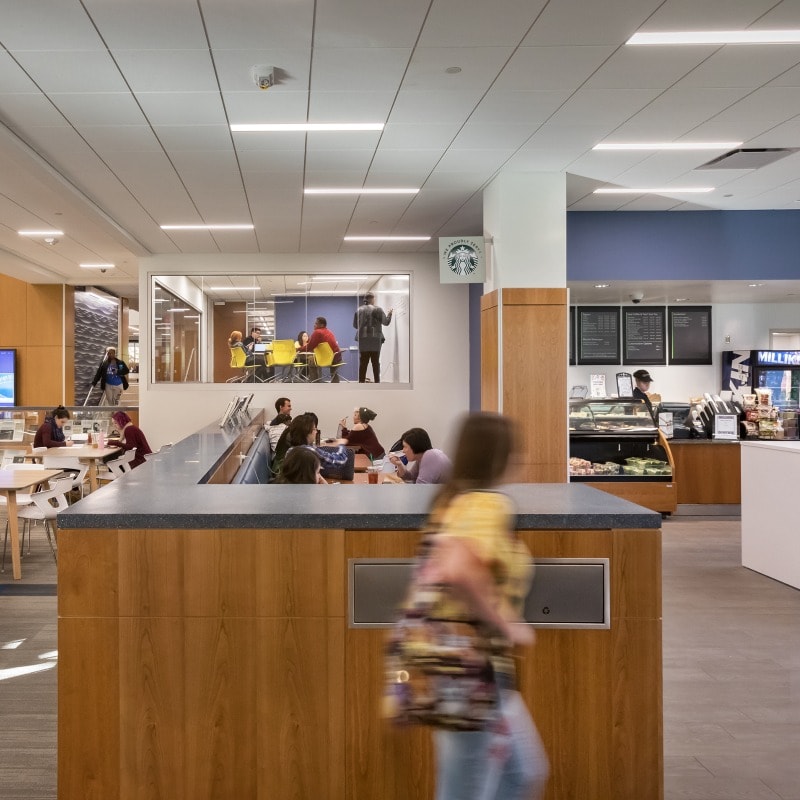Building the Future of Hybrid Student Facilities

Wednesday, December 15, 2021
Hybrid student facilities – those that house a variety of athletic, recreation, wellness, dining, academic and student services under one roof – are here to stay on college and university campuses. By creating truly multifunctional facilities, institutions can build a stronger sense of community, boost student engagement and retention, and mitigate capital improvement challenges.
Until recent decades, student health and wellness services have been offered separately from athletics and recreation. Similarly, dining, academic, and student service functions were rarely integrated. However, hybrid facilities that bring these many functions together can make great strides in fostering community in a cost-effective manner on any size college campus. This model of pooling resources and input from multiple campus departments and groups into a singular project that serves all is quite advantageous. Not only can this sort of cross-campus collaboration help overcome funding challenges, it can also strengthen the relationship between previously-separated student-focused functions, which ultimately creates a more holistic student experience.
Having designed a number of hybrid student facilities such as University Commons at Millikin University, the Human Performance Center at Utah Tech University, and the Student Life Center at SUNY Cortland, our lead designers share that many components must be accounted for when combining many functions in one facility. In order to reap the full benefits of a hybrid facility that supports many facets of student life, the following components should be considered during the programming stage of a project:
One-Stop
Students expect to have access to activities and services efficiently and without hassle. We have seen increased desire to have “one-stop” or “hybrid” recreation and student life facilities that include recreation amenities, social lounges, classrooms, wellness activities, and food service as well as health and counseling services. As a result of this service integration, these hybrid facilities often become a key social hub on campus. It is important to work closely with students and administrators alike to tailor these special social environments to reflect the unique character and culture of each campus.
Group Study & Breakout Space
There is a growing student interest in centrally-located meeting and study spaces in the heart of campus. Often, students enjoy the ability to socialize or study before or after working out, health appointments, organization meetings, and more. These informal settings are often more conducive to learning than traditional classrooms. Many new student life facilities include fully-equipped breakout spaces that are designed for multiple uses. Flexible furniture and a highly visible location are key to maximizing space use. More formal gathering rooms can accommodate student organizations, seminars, study groups, or student projects.
User-Focused Design
When configuring and arranging the components of a hybrid facility, it is essential to try to put yourself in the shoes of the user. For example, clustering similar spaces together on the same floor increases convenience and maximizes the utility of each space. When looking for an available group room, no one wants to traipse from floor to floor looking for an open room. The same user-focused approach applies when wayfinding is considered. Designers should always integrate clearly-visible pathways using architectural features, colors, and directional signage, so that visitors entering the facility for the first time can immediately see their destination.
Revenue-Generating Opportunities
We always look for creative approaches to generate additional revenue in the facilities we design. Student preferences and interests change over time, and trends come and go. Surveying students regarding their preferences and interests often yields positive results. Flexible, fee-based multipurpose rooms (storefront-style) can be easily repurposed through theming and branding. This lets an institution make cost-effective programming changes that support the interests of students and other users. For example, a martial arts room could be converted to a boxing gym. A group fitness room could be converted to a functional training room. Even such recreation-focused spaces could be converted to accommodate other student services as the needs arises, such as a first-year student center, mail room, and more.
While there are many other considerations that go into creating a successful hybrid facility that supports the mission, needs, and aspirations of a particular institution, the previous points area a good point of discussion for many institutions.
To learn more about strategies behind creating successful hybrid facilities on college and university campuses, contact Erik Kocher at [email protected] or (314) 529-4004.